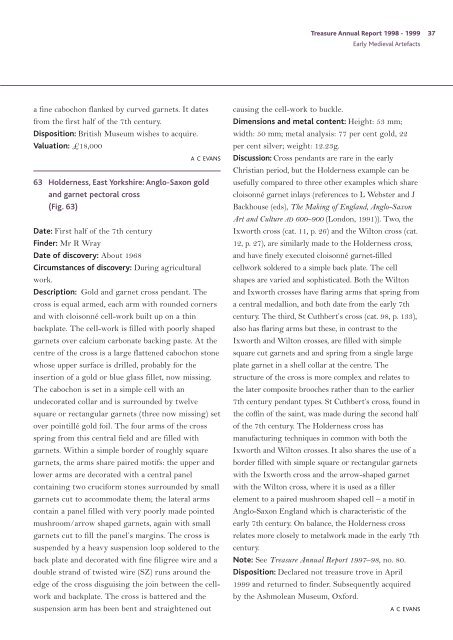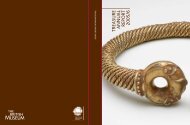Treasure Annual Report 1998-1999 - Portable Antiquities Scheme
Treasure Annual Report 1998-1999 - Portable Antiquities Scheme
Treasure Annual Report 1998-1999 - Portable Antiquities Scheme
You also want an ePaper? Increase the reach of your titles
YUMPU automatically turns print PDFs into web optimized ePapers that Google loves.
a fine cabochon flanked by curved garnets. It dates<br />
from the first half of the 7th century.<br />
Disposition: British Museum wishes to acquire.<br />
Valuation: £18,000<br />
A C EVANS<br />
63 Holderness, East Yorkshire: Anglo-Saxon gold<br />
and garnet pectoral cross<br />
(Fig. 63)<br />
Date: First half of the 7th century<br />
Finder: Mr R Wray<br />
Date of discovery: About 1968<br />
Circumstances of discovery: During agricultural<br />
work.<br />
Description: Gold and garnet cross pendant. The<br />
cross is equal armed, each arm with rounded corners<br />
and with cloisonné cell-work built up on a thin<br />
backplate. The cell-work is filled with poorly shaped<br />
garnets over calcium carbonate backing paste. At the<br />
centre of the cross is a large flattened cabochon stone<br />
whose upper surface is drilled, probably for the<br />
insertion of a gold or blue glass fillet, now missing.<br />
The cabochon is set in a simple cell with an<br />
undecorated collar and is surrounded by twelve<br />
square or rectangular garnets (three now missing) set<br />
over pointillé gold foil. The four arms of the cross<br />
spring from this central field and are filled with<br />
garnets. Within a simple border of roughly square<br />
garnets, the arms share paired motifs: the upper and<br />
lower arms are decorated with a central panel<br />
containing two cruciform stones surrounded by small<br />
garnets cut to accommodate them; the lateral arms<br />
contain a panel filled with very poorly made pointed<br />
mushroom/arrow shaped garnets, again with small<br />
garnets cut to fill the panel’s margins. The cross is<br />
suspended by a heavy suspension loop soldered to the<br />
back plate and decorated with fine filigree wire and a<br />
double strand of twisted wire (SZ) runs around the<br />
edge of the cross disguising the join between the cellwork<br />
and backplate. The cross is battered and the<br />
suspension arm has been bent and straightened out<br />
<strong>Treasure</strong> <strong>Annual</strong> <strong>Report</strong> <strong>1998</strong> - <strong>1999</strong> 37<br />
Early Medieval Artefacts<br />
causing the cell-work to buckle.<br />
Dimensions and metal content: Height: 53 mm;<br />
width: 50 mm; metal analysis: 77 per cent gold, 22<br />
per cent silver; weight: 12.23g.<br />
Discussion: Cross pendants are rare in the early<br />
Christian period, but the Holderness example can be<br />
usefully compared to three other examples which share<br />
cloisonné garnet inlays (references to L Webster and J<br />
Backhouse (eds), The Making of England, Anglo-Saxon<br />
Art and Culture AD 600–900 (London, 1991)). Two, the<br />
Ixworth cross (cat. 11, p. 26) and the Wilton cross (cat.<br />
12, p. 27), are similarly made to the Holderness cross,<br />
and have finely executed cloisonné garnet-filled<br />
cellwork soldered to a simple back plate. The cell<br />
shapes are varied and sophisticated. Both the Wilton<br />
and Ixworth crosses have flaring arms that spring from<br />
a central medallion, and both date from the early 7th<br />
century. The third, St Cuthbert’s cross (cat. 98, p. 133),<br />
also has flaring arms but these, in contrast to the<br />
Ixworth and Wilton crosses, are filled with simple<br />
square cut garnets and and spring from a single large<br />
plate garnet in a shell collar at the centre. The<br />
structure of the cross is more complex and relates to<br />
the later composite brooches rather than to the earlier<br />
7th century pendant types. St Cuthbert’s cross, found in<br />
the coffin of the saint, was made during the second half<br />
of the 7th century. The Holderness cross has<br />
manufacturing techniques in common with both the<br />
Ixworth and Wilton crosses. It also shares the use of a<br />
border filled with simple square or rectangular garnets<br />
with the Ixworth cross and the arrow-shaped garnet<br />
with the Wilton cross, where it is used as a filler<br />
element to a paired mushroom shaped cell – a motif in<br />
Anglo-Saxon England which is characteristic of the<br />
early 7th century. On balance, the Holderness cross<br />
relates more closely to metalwork made in the early 7th<br />
century.<br />
Note: See <strong>Treasure</strong> <strong>Annual</strong> <strong>Report</strong> 1997–98, no. 80.<br />
Disposition: Declared not treasure trove in April<br />
<strong>1999</strong> and returned to finder. Subsequently acquired<br />
by the Ashmolean Museum, Oxford.<br />
A C EVANS





